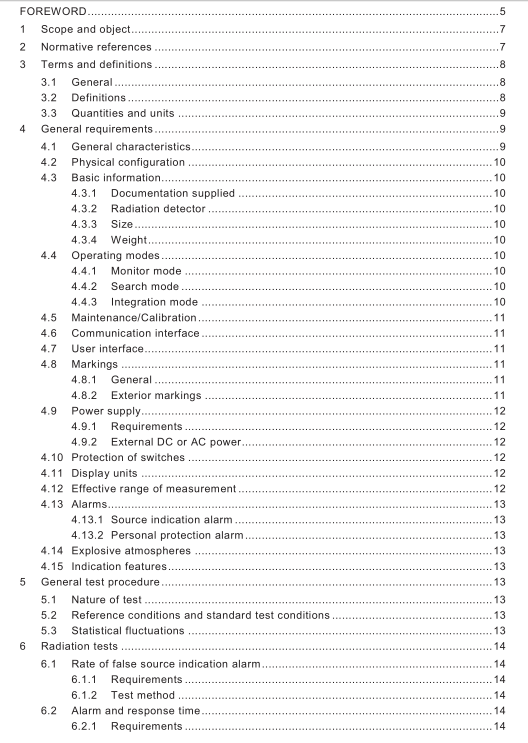IEC 62534 pdf – Radiation protection instrumentation — Highly sensitive hand-held instruments for neutron detection of radioactive material

IEC 62534 pdf – Radiation protection instrumentation — Highly sensitive hand-held instruments for neutron detection of radioactive material
1 Scope and object
This International Standard applies to hand-held instruments used for the detection andlocalization of neutron emitting radioactive material.These instruments are highly sensitivemeaning that they are designed to detect slight variations in the range of usual backgroundthat may be caused by illicit trafficking or inadvertent movement of radioactive material. Thishigh sensitivity allows scanning of larger volume items such as vehicles and containers.These instruments may also be used in fixed or temporally fixed unattended mode to monitorcheck points or critical areas. Instruments addressed by this standard will also provide ameans to detect photon radiation for personal protection.
This standard does not apply to the performance of radiation protection instrumentation whichis covered in lEC 61005 and in lEC61526.
The object of this standard is to establish performance requirements,provide examples ofacceptable test methods, and to specify general characteristics,general test conditions,radiation characteristics,electrical safety, and environmental characteristics, that are used todetermine if an instrument meets the requirements of this standard.
The results of tests performed provide information to government agencies and other users onthe capability of radiation detection instruments for reliably detecting neutron sources.
Obtaining operating performance that meets or exceeds the specifications as stated in thisstandard depends upon properly establishing appropriate operating parameters,maintainingcalibration,implementing a’suitable response testing and maintenance program,auditingcompliance with quality requirements,and providing proper training for operating personnel.
2 Normative references
The following referenced documents are indispensable for the application of this document.For dated references, only the edition cited applies.For undated references, the latest editionof the referenced document (including any amendments) applies.
IEC 60050-393:2003,International Electrotechnical Vocabulary (IEV) – Part 393: Nuclearinstrumentation – Physical phenomena and basic concepts
IEC 60050-394:2007, International Electrotechnical Vocabulary – Part 394: Nuclearinstrumentation – Instruments,systems, equipment, and detectors
IEC 60529:2001,Degrees of protection provided by enclosures (IP Code)
IEC 61000-4-2:2008, Electromagnetic compatibility(EMC) – Part 4-2: Testing andmeasurement techniques – Electrostatic discharge immunity test
IEC 61005:2003,Radiation protection instrumentation – Neutron ambient dose equivalent(rate) meters
IEC 61526:2005,Radiation protection instrumentation – Measurement of personal doseequivalents Hp(10) and Hp(0,07) for x, gamma, neutron and beta radiations -Direct readingpersonal dose equivalent meters and monitors
lSo 8529-1:2001,Reference neutron radiations – Part 1: Characteristics and methods ofproduction
3Terms and definitions
3.1General
For the purposes of this document, the following terms and definitions apply.
NOTE Radiation quantities and dosimetric terms are from lEC 60050-393 and IEC 60050-394.
3.2Definitions
3.2.1
acceptance test
contractual test to prove to the customer that the instrument fulfils certain specifications[lEV 151-16-23,modified]
[IEv 394-40-05,modified]
3.2.2
alarm
audible,visual, or other signal activated when the instrument reading exceeds a preset valueor falls outside of a preset range
[IEv 393-18-03,modified]
3.2.3
background level
radiation field in which the instrument is intended to operate which includes backgroundproduced by naturally occurring radioactive material
3.2.4
conventionally true value
value attributed to a particular quantity and accepted, sometimes by convention, as having anuncertainty appropriate for a given purpose
NOTE Conventionally true value of a quantity is sometimes called assigned value,best estimate of the value,conventional walue or reference value.
[lEv 394-40-10]
3.2.5
false alarm
alarm not caused by an increase in radiation level over background conditions
3.2.6
functionality test
test performed to verify that alarms activate and that radiation detection is acceptable
3.2.7
influence quantity
quantity that may have a bearing on the result of a measurement without being the subject ofthe measurement
3.2.8
manufacturer
includes the designer of the equipment
3.2.9
point of measurement
place at which the conventionally true values are determined and at which the reference point of the instrument is placed for calibration or test purposes
3.2.1 0
purchaser
includes the user of the equipment
3.2.1 1
radioactive material
in this standard, radioactive material includes special nuclear material, unless otherwise specifically noted
3.2.1 2
reference point of an instrument
mark on the equipment at which the instrument is positioned for the purpose of calibration and testing
NOTE The point from which the distance to the source is measured.
[IEV 394-40-1 5, modified]
3.2.1 3
type test
conformity test made on one or more items representative of the production
[IEV 1 51 -1 6-1 6]
[IEV 394-40-02]
3.3 Quantities and units
In the present standard, units of the International System (SI) are used 1 . The definitions of radiation quantities are given in IEC 60050-393, IEC 60050-394.
The following units may also be used:
– for energy: electron-volt (symbol: eV), 1 eV = 1 ,602 × 1 0 –1 9 J;
– for time: years (y), days (d), hours (h), minutes (min).









